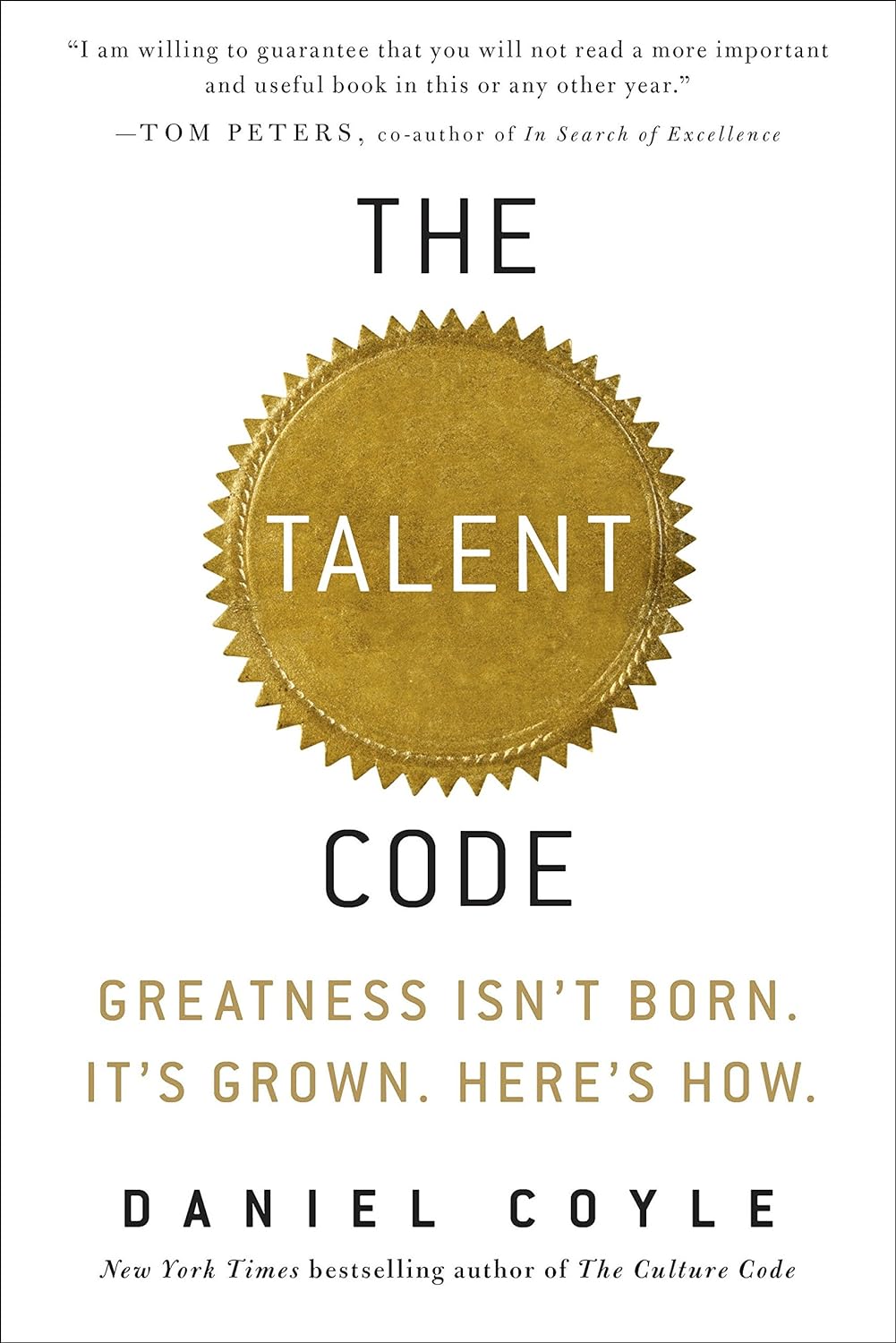Deep Practice
In "The Talent Code" by Daniel Coyle, the concept of Deep Practice is a game-changer for anyone looking to master a skill. Daniel Coyle dives into the fascinating world of how deliberate, focused practice can turn ordinary individuals into extraordinary talents.
Deep Practice is all about quality over quantity. It's not just about putting in hours; it's about making those hours count. Coyle reveals that when you engage in Deep Practice, you're not just going through the motions. Instead, you're actively involved in the process, making mistakes, correcting them, and continually pushing your boundaries. This intense focus helps to build myelin, a substance in our brains that wraps around nerve fibers, making our thoughts and movements faster and more precise.
Coyle shares inspiring examples from diverse fields, showing how Deep Practice works wonders. He takes us to a tiny Russian tennis club that produced more top-20 women players than the entire United States. The secret? The players didn't just hit thousands of balls; they hit them with purpose, constantly correcting their form and technique.
One of the key insights from Coyle is that making mistakes is a crucial part of Deep Practice. He quotes, “Struggle is not an option, it’s a biological necessity.” When you struggle and stumble, your brain is working overtime, reinforcing the correct patterns and building those essential myelin layers.
To make Deep Practice work for you, Coyle suggests breaking down skills into smaller, manageable chunks. This method, known as chunking, allows you to focus on mastering each part before putting it all together. It's like learning to play a musical instrument by mastering individual notes and then combining them into a beautiful melody.
Coyle's enthusiasm for Deep Practice is infectious. He assures us that anyone can benefit from this approach, regardless of their starting point. “Greatness isn’t born, it’s grown,” he writes, emphasizing that with the right kind of practice, we can all unlock our potential.
Ignition
Ignition is that electrifying moment when inspiration strikes and fuels an intense drive to excel. Coyle vividly describes how these moments of ignition spark a deep, almost uncontainable desire to pursue a passion with relentless enthusiasm.
Coyle highlights the story of a young Brazilian soccer player, inspired by watching his idol score an incredible goal. This moment of awe ignited a burning ambition within him to become a soccer star. Coyle writes, “Greatness isn't born, it's grown. And the brain is the key to that growth.” This insight underscores the transformative power of ignition in setting individuals on a path toward exceptional achievement.
Ignition is not merely about fleeting excitement; it’s about a profound emotional experience that triggers a long-lasting commitment to a goal. Coyle explains how these moments often involve witnessing excellence firsthand or experiencing a personal revelation. He quotes a famous saying, “You are the average of the five people you spend the most time with,” to emphasize the impact of surrounding oneself with inspiring figures and environments.
One of the most compelling aspects of ignition is its ability to turn dreams into tangible goals. Coyle shares numerous stories of athletes, musicians, and artists who, after experiencing their ignition moment, dedicated themselves to rigorous practice and continuous improvement. He describes how a young violinist, after attending a mesmerizing concert, decided to practice five hours a day to emulate the virtuosity she had witnessed.
Coyle’s exploration of ignition also delves into the importance of nurturing environments that can trigger these moments. He points out that schools, communities, and families play a crucial role in creating opportunities for ignition by exposing individuals to role models and extraordinary performances. “When we watch those who are great, we are inspired to be great,” Coyle asserts, highlighting the contagious nature of excellence.
Master Coaching
Master coaches are not just instructors; they are sculptors of skill and vision. They possess an uncanny ability to identify the unique strengths and weaknesses of their students, providing tailored feedback that propels them toward greatness. Coyle writes, "Great coaches know how to light the fire within their students, guiding them with precision and empathy."
A key characteristic of master coaches is their unwavering commitment to fostering a growth mindset. They encourage their students to embrace challenges, view failures as learning opportunities, and persist in the face of adversity. Coyle shares inspiring stories of legendary coaches like John Wooden, who emphasized the importance of effort and resilience over immediate results. As Wooden famously said, “Success is never final, failure is never fatal. It’s courage that counts.”
Another hallmark of master coaching is the ability to create an environment where deep practice can thrive. Coyle describes how these coaches design practice sessions that push students to their limits, focusing on the intricate details that lead to skill mastery. This approach not only builds technical proficiency but also instills a sense of discipline and perseverance.
Coyle also highlights the importance of clear, constructive feedback in the coaching process. Master coaches provide specific, actionable insights that help students refine their techniques and overcome obstacles. This continuous feedback loop is essential for sustained improvement and growth.
Moreover, master coaches inspire through their own passion and dedication. They lead by example, demonstrating the same commitment to learning and improvement that they expect from their students. This infectious enthusiasm creates a powerful bond and fosters a culture of excellence.
Chunking
Chunking is all about breaking down intricate tasks into smaller, manageable pieces, making the learning process not only more efficient but also incredibly rewarding.
Daniel Coyle reveals that by focusing on one small part of a skill at a time, you can dive deep into the nuances and perfect each element before moving on to the next. This methodical approach helps to build a solid foundation, ensuring that each chunk is thoroughly understood and mastered. Coyle quotes, “Greatness isn’t born, it’s grown,” emphasizing that talent is cultivated through deliberate practice, one chunk at a time.
Take, for example, learning to play a musical instrument. Instead of attempting to master an entire piece of music in one go, chunking encourages you to break it down into sections—perhaps focusing on a few bars at a time. By dedicating your efforts to perfecting each section, you gradually build the proficiency needed to play the entire piece flawlessly. Coyle illustrates this by referencing how renowned musicians practice, noting that “they aren’t merely playing—they’re deeply engaged in fixing, honing, and improving each part.”
Coyle also shares the inspiring story of the Clarissa Eden Soccer Academy, where young athletes are taught to master their skills through chunking. Instead of playing full matches, they spend significant time working on specific drills that isolate particular movements or techniques. This targeted practice enables them to refine their skills with precision and then seamlessly integrate them into their overall game.
Furthermore, chunking isn’t limited to physical skills. It applies equally well to intellectual pursuits, such as learning a new language. By focusing on mastering individual words or phrases before constructing complex sentences, learners can build a robust vocabulary and grammatical understanding. Coyle's insights remind us that “small daily improvements over time lead to stunning results.”
Passion and Persistence
Coyle passionately argues that talent isn't born; it's grown through relentless effort and a deep-seated love for what you do. He highlights that passion is the spark that ignites the flame of persistence. “Passion isn’t just a bonus; it’s the fuel that powers the journey,” Coyle writes, emphasizing how a profound love for an activity keeps individuals motivated, even when the going gets tough.
The stories in the book are both inspiring and enlightening. Take the example of world-renowned violinist Itzhak Perlman. Coyle shares how Perlman’s passion for music was evident from a young age, and it was this love that kept him practicing tirelessly, even when faced with challenges. Perlman once said, “The most important thing is to love what you’re doing, because then you will work hard and never give up.” This quote encapsulates the heart of Coyle's message – that passion drives persistence, and persistence leads to greatness.
Coyle delves into the concept of "grit," a combination of passion and perseverance, which psychologist Angela Duckworth also explores in her research. He explains how grit is a critical component in achieving long-term goals. Those who succeed aren’t necessarily the ones with the most talent but those who refuse to give up. Coyle writes, “Grit, more than talent, is what separates the successful from the rest.”
Another compelling story is that of Brazilian soccer players, who practice diligently in makeshift fields, driven by their love for the game. Their passion for soccer fuels their daily practice, helping them to refine their skills and rise to the top. Coyle notes, “Their love for the game transforms every obstacle into an opportunity to learn and grow.”
Neuroplasticity and Myelin
Daniel Coyle takes us on an exhilarating journey into the brain's miraculous ability to develop talent through neuroplasticity and the powerful role of myelin. Coyle explains that our brains are not static but dynamic organs capable of incredible growth and adaptation. This concept of neuroplasticity is at the heart of how we acquire and refine skills.
Coyle vividly describes myelin as the "holy grail" of skill acquisition. Myelin is a fatty tissue that wraps around our neural circuits, acting as insulation that allows electrical signals to move faster and more efficiently. He states, “Skill is myelin insulation that wraps neural circuits and that grows according to certain signals.” The more we practice a skill, the more myelin our brains produce, enhancing the speed and accuracy of our movements and thoughts.
The beauty of Coyle's insight is in its simplicity and universality. He shows us that whether you're learning to play a musical instrument, mastering a new language, or excelling in sports, the process of building myelin is the same. Coyle emphasizes, “Every skill, whether physical or mental, is created by chains of nerve fibers carrying a tiny electrical impulse—basically, a signal traveling through a circuit.”
To bring this concept to life, Coyle shares compelling stories of athletes, musicians, and performers who have harnessed the power of myelin through deep practice. He describes how Brazilian soccer players, trained in small, crowded spaces, develop extraordinary skills due to the intense, repetitive practice that builds myelin around their neural circuits. “When you see a great performer, you are seeing a great practice,” Coyle notes, highlighting the invisible but crucial role of myelin.
Neuroplasticity and myelin also offer a message of hope and empowerment. Coyle's research reassures us that talent is not an innate gift but a result of hard work and effective practice. “Your brain can grow new connections and strengthen existing ones at any age,” he writes, reminding us that it's never too late to start building new skills.

